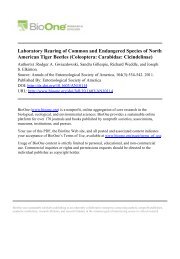Building Models from Experimental Data. - elkintonlab
Building Models from Experimental Data. - elkintonlab
Building Models from Experimental Data. - elkintonlab
Create successful ePaper yourself
Turn your PDF publications into a flip-book with our unique Google optimized e-Paper software.
Pathogen-Driven Outbreaks Revisited 113<br />
Figure 5: Cycle periodicity and the parameter range that permits stable<br />
cycles for the short-epidemic model. The cycle period and the chance of<br />
unstable cycles both increase as fecundity l decreases.<br />
of stable cycles given the high levels of heterogeneity in<br />
susceptibility in the data.<br />
Given that our transmission data do not preclude the<br />
possibility of outbreaks, we also compare the model to<br />
gypsy moth population data more quantitatively. Specifically,<br />
gypsy moth populations typically fluctuate over<br />
about four orders of magnitude in density (Elkinton and<br />
Liebhold 1990), and so we ask, Does the model show this<br />
amplitude of fluctuations for realistic parameter values<br />
We define amplitude to mean the difference in density<br />
between peaks and troughs of the population cycle. Figure<br />
5 shows that cycle period increases with increasing values<br />
of pathogen carryover f and decreasing values of fecundity<br />
l and heterogeneity in susceptibility C, matching the effects<br />
of these parameters on the boundary between limit<br />
cycles and a stable equilibrium. Figure 5 also shows that<br />
the model can match the observed 9-yr period of gypsy<br />
moth population fluctuations for a broad range of parameter<br />
values. The further requirement of an amplitude of<br />
fluctuation of about four orders of magnitude, however,<br />
means that fecundity l must be about 5 (not shown).<br />
Here, “fecundity” is interpreted to mean “net population<br />
change in the near-absence of the disease” rather than<br />
“eggs per egg mass” (Hassell et al. 1976). Under this definition,<br />
observed net gypsy moth fecundity l is about 11<br />
(Elkinton et al. 1996). Given that the variance in net gypsy<br />
moth fecundity <strong>from</strong> year to year is large ( SE=9.1,<br />
n=<br />
8), model and data are in approximate agreement.<br />
More quantitatively, in figure 6, we show the best fit of<br />
the model to a time series for gypsy moth (Ostfeld et al.<br />
1996). By first transforming the data according to<br />
log e[N t1/N t]<br />
(Turchin and Taylor 1992), we were able to<br />
fit the nondimensionalized short-epidemic model to the<br />
data using only fecundity l, heterogeneity C, and pathogen<br />
survival f (app. A; note that we assume g =0). We found<br />
the best-fit values of these parameters by calculating the<br />
sum of the squared differences between the model and the<br />
data for parameter combinations that spanned the area of<br />
parameter space in which the model shows stable cycles.<br />
To generate the figure, we then used the model output for<br />
the best-fit values of the parameters and varied the ratio<br />
¯n/m until we had achieved a good fit between the host<br />
density predicted by the model and the host density in the<br />
data (app. A), as determined again by least squares. Although<br />
this time series is short and is based on a sampling<br />
area of only 0.16 ha (in particular the low points of each<br />
cycle are based on very small sample sizes; Ostfeld et al.<br />
1997), nevertheless, figure 6 demonstrates that the model<br />
does a good job of reproducing the data. Also, estimates<br />
Figure 6: Best fit of the short-epidemic model to time series data for<br />
gypsy moth Lymantria dispar (Ostfeld et al. 1996). Parameter values are<br />
fecundity l = 5.5, heterogeneity in susceptibility C=0.86, and pathogen<br />
overwinter survival f =15. Table 1 gives the value of n¯<br />
.



